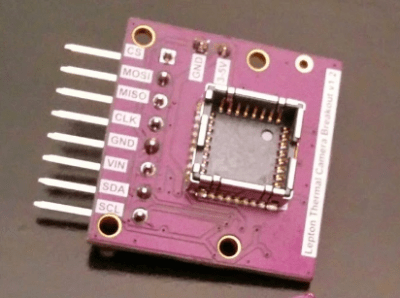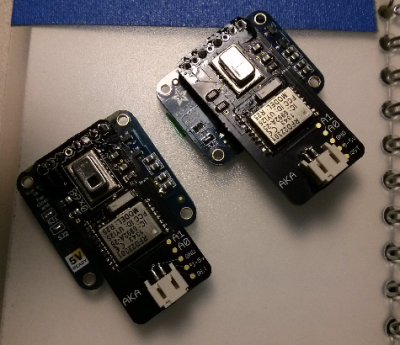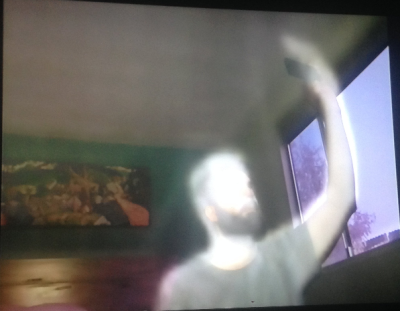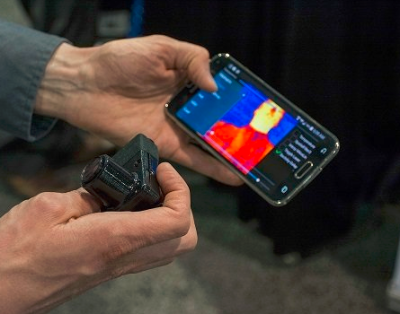Thermal imaging is the science of converting the heat signature of objects to an image visible to humans. Everything above absolute 0 gives off some heat, and thermal imagers allow us to see that – even if there is no visible light in the room. Historically, thermal imaging systems have been large and expensive. Early systems required liquid nitrogen cooling for their bolometer sensors. Recent electronic advances have brought the price of a thermal image system from the stratosphere into the sub $300 range – right about where makers and hackers can jump in. That’s exactly what’s happened with the Flir Lepton module and the Seek Thermal camera. This week’s Hacklet is all about thermal imaging projects on Hackaday.io!
 We start with [Pure Engineering] and Flir Lepton Thermal Camera Breakout. Flir’s Lepton thermal camera created quite a stir last year when it debuted in the Flir One thermal iPhone camera. The Lepton module used in the Flir One is a great standalone unit. Interfacing only requires an I2C interface for setup and an SPI interface for image data transfer. Actually using the Lepton is a bit more of a challenge, mainly because of its packaging. [Pure Engineering] made a simple breakout board which makes using the Lepton easy. It’s also breadboard compatible – which is a huge plus in the early phases of any project.
We start with [Pure Engineering] and Flir Lepton Thermal Camera Breakout. Flir’s Lepton thermal camera created quite a stir last year when it debuted in the Flir One thermal iPhone camera. The Lepton module used in the Flir One is a great standalone unit. Interfacing only requires an I2C interface for setup and an SPI interface for image data transfer. Actually using the Lepton is a bit more of a challenge, mainly because of its packaging. [Pure Engineering] made a simple breakout board which makes using the Lepton easy. It’s also breadboard compatible – which is a huge plus in the early phases of any project.
 Next up is [AKA] with GRID-EYE BLE-capable thermal camera. This project is a Bluetooth low energy (BLE) thermal camera using Panasonic’s Grid-EYE 64 pixel thermal sensor. 64 pixels may not sound like much, but an 8×8 grid is enough data to see quite a bit of temperature variation. If you don’t believe it, check the project page for a video of [AKA] using Grid-EYE’s on-board OLED display. Grid-EYE was a Hackaday Prize 2014 semifinalist, and we featured a bio on [AKA] last year. The only hard part with building your own Grid-EYE is getting the sensor itself. Panasonic doesn’t sell them to just anyone, so you might have to jump through a few hoops to get your own.
Next up is [AKA] with GRID-EYE BLE-capable thermal camera. This project is a Bluetooth low energy (BLE) thermal camera using Panasonic’s Grid-EYE 64 pixel thermal sensor. 64 pixels may not sound like much, but an 8×8 grid is enough data to see quite a bit of temperature variation. If you don’t believe it, check the project page for a video of [AKA] using Grid-EYE’s on-board OLED display. Grid-EYE was a Hackaday Prize 2014 semifinalist, and we featured a bio on [AKA] last year. The only hard part with building your own Grid-EYE is getting the sensor itself. Panasonic doesn’t sell them to just anyone, so you might have to jump through a few hoops to get your own.
 [Kurt Kiefer] brought the FLIR Lepton to the Raspberry Pi with pylepton video overlay. This project uses the Lepton to overlay thermal data with images captured by the Raspbery Pi camera module. The Lepton interfaces through the I2C and SPI ports on the Pi’s GPIO pins. The results are some ghostly images of black and white thermal views over color camera images – perfect for your next ghost hunting expedition! The entire project is implemented in Python, so it’s easy to import and use pylepton in your own projects. [Kurt] even gives an example of capturing an image with just 5 lines of code. Nice work, [Kurt]!
[Kurt Kiefer] brought the FLIR Lepton to the Raspberry Pi with pylepton video overlay. This project uses the Lepton to overlay thermal data with images captured by the Raspbery Pi camera module. The Lepton interfaces through the I2C and SPI ports on the Pi’s GPIO pins. The results are some ghostly images of black and white thermal views over color camera images – perfect for your next ghost hunting expedition! The entire project is implemented in Python, so it’s easy to import and use pylepton in your own projects. [Kurt] even gives an example of capturing an image with just 5 lines of code. Nice work, [Kurt]!
 Finally we have [Erik Beall] with WiFi Thermal Camera. [Eric] is using an 82×62 diode array to create thermal images. Unlike microbolometer sensors, diode/thermopile sensors don’t need constant calibration. They also are sturdier than Microelectricomechanical System (MEMS) based devices. This particular project users an array from Heimann Sensor. As the name implies, the sensor is paired with a WiFi radio, which makes using it to capture and display data easy. [Erik] must be doing something right, as WiFi Thermal Camera just finished a very successful Kickstarter, raising $143,126 on a $40,000 initial goal.
Finally we have [Erik Beall] with WiFi Thermal Camera. [Eric] is using an 82×62 diode array to create thermal images. Unlike microbolometer sensors, diode/thermopile sensors don’t need constant calibration. They also are sturdier than Microelectricomechanical System (MEMS) based devices. This particular project users an array from Heimann Sensor. As the name implies, the sensor is paired with a WiFi radio, which makes using it to capture and display data easy. [Erik] must be doing something right, as WiFi Thermal Camera just finished a very successful Kickstarter, raising $143,126 on a $40,000 initial goal.
Are you inspired? A thermal imager can be used to detect heat loss in buildings, or heat generated by electrical faults – which means it would be a great project for the 2015 Hackaday Prize! If you want to see more thermal imaging projects, check out the thermal imaging projects list!
That’s it for this week’s Hacklet, As always, see you next week. Same hack time, same hack channel, bringing you the best of Hackaday.io!
















DigiKey sells the GridEye both by itself and on an evaluation board. I’m using one of the latter on a project in the lab, and although the resolution is only 8 x 8 it’s relatively inexpensive, sturdy, quite handy to use and fairly easy to pull data out of (I’ve got it sending data to MATLAB via the USB connection). Comes with a GUI to play with but the author won’t spill on it (it’s in VBasic).
http://www.digikey.com/catalog/en/partgroup/grideye-breakout-board-and-gui/41774
I’m also working with one of the PureEngineering Leptons to get the resolution up, and although the breakout works, getting to the next step isn’t nearly as simple since you need to get the SRI output to something the PC can use. I started with a Nucleo F411RE board that PureEngineering used in their project, but these have so few useful (to me) resources that I’m stumped and having to back up and using an Aardvark I2C/SRI adapter to get the output into the PC so that I can take advantage of FLIR’s toolset. Love the Nucleo board but if someone has a (very) idiot-resistant tutorial on getting PE Lepton board to talk to the PC through one, I’d love to hear about it.
https://hackaday.io/project/1974-tj-99-thermal-imager
Can’t believe you didn’t mention this one…maybe because he was a 2014 semfinalist and lost his instrinic motivation?
I was on the fence about including TJ – but I did add it to the list.
Off-topic post here – non Thermal imaging related. Meta HaD related.
“lost his intrinsic motivation”
Can’t tell you what TJ felt. However I CAN tell you my personal experience in prize/entry based competition. I was a semi-finalist in a Last Man Standing National FPS completion. You might say what does some sort of first person shooter game have to do with mechanics or electronics. Well. Timing, Routes, Weight Based Criteria of optimal paths and running an extreme amount of simulations against heavily exclusive errors and completion of goals is vital.
Long story short it turns out that there were 3 others on the same “team” (clan) that were in concordance to splitting the grand prize among themselves. In every instance I would defeat 2 out of those 3 however the timing and routes combined behaviors and willingness from others to sacrifice their team mates in order to stop me allowed them to place 1,2,3.
Truth is it HaD isn’t just sole tinkers, inventors and dreamers here. There are jerk offs from grad programs from different universities, startups and even frat houses that are competing against each other. Heaven help the sole inventor that attempts something who ISN’T someone that attempts to gain skulls.
I really think you’re off base here – there are grad students, companies, and individuals competing for the Hackaday Prize. In general they work on the same team. The idea of sacrificing yourself to help a teammate win doesn’t really apply here. If you need more proof, check out the finalists and winners from last year’s Hackaday Prize. Teams and individual projects both made it.
“I really think you’re off base here”
[Adam Fabio] Sorry for the kant of my rant. It is entirely possible I’ve had too many experiences with co-workers, colleagues, people and toxic environments. It DOESN’T preclude the fact that we in-spite of our best intentions are still human and have egos. I really like HaD for the fact that there are people who document and seek to inspire others. Occasionally seeing open sharing of knowledge and techniques without bringing a superiority complex into the mix makes this place shine.
What can I say? I like it when I see individual blogs that chronicle a persons efforts. I have no interest in wading through empty github repos, or blank hackaday.io sites where people will tag imitations of projects that have no info. Sure the fraudsters, fakers and dramatics do get exposed but there is a lot of noise. That noise is enough to discourage or cause that person to feel like it isn’t worth the effort.
The best articles HaD has is ALWAYS teardown, re-purposing and improvements to existing techniques, methods, tools and equipment.
If the Hackaday prize had more breath and width pertaining to old or little known hardware I’d be more gung-ho about it. “Make something cool with the cheapest MP4 player you can find.”, “Document a build the cheapest and precise mini-Z-Axis CNC mill/lathe with harddrive or cdrom drive parts.”, “Use an array of garbage e-vapes to make a reflow station.” even something like “Thriftstore/fleamarket diamonds make something useful and awesome out of random stuff under $50 and show us the receipt and BOM”. THEN I’d be more inclined to say yes competing at this level is valuable. But come on All the modules listed above are about $100 bucks a piece. Meaning you have get the gear and have to be VERY competitive otherwise we’ve building a one-off knicknack that we can’t bear to throw away because we invested time and energy to say “Well I worked hard at this but it is barely useful other then I made it myself.”
But hey, maybe none of my points are valid. However it IS worth thinking about.
Digikey now stock the Flir Lepton BTW (and unlike the GridEye, will ship it outside USA)
“Everything above absolute 0 gives off some heat”
Nope, heat is transferred energy due to temp. difference. If the object is within the same temperature of its environment it does not give off heat.
What you are saying is true for conduction and convection but I think the author was talking about radiation, (what the sensor sees) which will happen no matter the environing temperature. There will be an equilibrium where the amount of heat radiated and absorbed are equal. But equilibrium does not mean no transfer.
Anything that has temperature above absolute zero produces radiation that can be measured remotely. The wavelength of the emitted radiation is determined by the temperature.
Even if no energy is transferred, an object can still have a defined temperature, and therefore it posses thermal energy – also know as “Heat”, even if it cannot be measured (due to lack of energy transfer).
Check out wikipedia entry for “Heat” disambiguation (http://en.wikipedia.org/wiki/Heat_(disambiguation) :)
As a technical term “heat” is transfer of thermal energy (from hot to cold). Thermal radiation != heat.
It’s all relative. Even if the object is in thermal equilibrium with it’s environment and not transferring energy to / from it, the thermal energy it has relative to absolute zero is still a positive (non zero) value.
But that is not heat! Gee.
These cameras are also great for hunting feral hogs, which are a great nuisance in some parts of America, like Texas, Louisiana, Mississippi, Alabama, and Georgia.
openmv had a thermal option too
I am still waiting for something small enough with a high enough pixel grid and quick enough
response to use for a (seriously) real time high-res thermal view predator helmet.
That’s been my holy grail of holy grails for decades now.
The idea of walking into the forest and spotting deer or bears with a colored, accurate thermal overlay
in realtime is intoxicating. No, I don’t need to shoot them with it on. Just finding them like that would
be cool as hell.
Someone tell me if I’m missing something here, is that feasable yet without 100,000$?
It seems this new stuff still has low fps and low density pixel grids.
The fps will be bad forever from what I know as its a government regulation. I don’t think it’s hack able either as its built into the chips.
There is no government regulation. It’s just physics.
ITAR would like to ask you some questions….
Over 9FPS is reserved for military uses :(
ITAR only applies to cameras exported from an ITAR country. If the camera is made for domestic use it can have higher frame rates. Cameras made in non ITAR countries can have higher frame rates and be imported into the US.
I wonder if some 3rd party like russia (or belarus) sells such devices online. And if so it would likely be much cheaper too.
I saw an ukrainian soldier say that the belarus nightvision stuff is way better than what the US gives them. Although I’m not sure what technology they were talking about, IR or thermo.
That’s not how ITAR works. ITAR is to prevent other (non-ITAR) countries from obtaining strategic technologies. Not to prevent US citizens from having it. A camera manufacturer can simply label a 30fps “Not for Export” and sell it in the US to anyone.
> Cameras made in non ITAR countries can have higher frame rates and be imported into the US
I see clear coincidence between countries with good cameras and ITAR regulations :(
Seek for an infrared camera and bring a big infrared lamp.
There’s also the Seek Thermal device designed for phones or tablets using USB OTG, but it has been hacked to the point the images can be viewed on anything with a usb host port and the right cable.
what, no love for MuOptics? :)
that project got canceled. http://thermalimaging-blog.com/41-mu-optics-thermal-camera-not-going-to-be-released/
I might sound spoiled, but I’m going to say it anyway: You’d think that in 2015 these things would be available at at east 320×240 resolution, instead of starting at the bottom like the first time digital cameras were invented. I would have thought with modern production technology andsoforth we would not need to start at the bottom..
Yeah- I never understood that either! I figured there ought to be at least
that res by now- can anyone comment on why these things still have such
low resolutions after this many years?
And why the low FPS? No way around that? Physics? Explain.
That’s easily a cop-out answer if you can’t. No hate, I just want to understand.
I love how the first thoughts were I am looking to do something bad with the
tech. I don’t want to do anything bad with it at all. Damnit, there are people
who can see things I never will- they are called tetrachromats. Ever hear of
transhumanists? I want to use tech to augment my abilities, my experiences
as much as possible, to the limits of what my brain can percieve.
Can you imagine walking around for a day, not letting light be a factor in your
view of the world? Can you imagine for one minute wanting to see what that
would be like?
Must everything boil down to smartphone apps for fart sounds and ways to
hurt others? I hope not.
I believe the frame rate is low because of physics, the detector on this is uncooled to get faster frame rates you would have to cool the detector which means a much larger and expensive camera. same goes for the low res problem it’s because no matter how easy it is to make these detectors now they’re still make from rare expensive materials. so to make it cheep you have to do something like lower the resolutions.
Sorry to disappoint, but the frame rate is locked low because of ITAR (International Traffic in Arms Regulations) export restrictions. Basically the government doesn’t want heat seeking missiles to be any easier.
Most of these devices can run much faster:
http://www.flir.com/cvs/cores/knowledgebase/index.cfm?CFTREEITEMKEY=342&view=35781
No, It’s not. A US manufacturer can simply label the device “Not for Export” and sell it to any American citizen or American company. If ITAR were the problem (and not physics), then where are the high frame rate bolometer arrays coming out if China?
If you want high frame rates you use HgCdTe arrays. you can get them in 1024×1024 focal plane arrays and 100fps – but, you will need to cool it with liquid nitrogen.
The frame rate is low on bolometer type sensors due to physics. The pixels need to be thermally isolated from each other, but they have thermal mass and take time to change temperature. They need some thermal contact with the substrate, but not too good, otherwise it won’t be sensitive to thermal IR wavelengths.
The semiconductor sensors (like HgCdTe) are directly sensitive to the Thermal IR photons (due to the bandgap of the material) and therefore can sense changes much faster. They are cooled to reduce dark current and electronic noise.
Microbolometer type sensors have low frame rates and lower resolution purely due to physics. The pixels need to be thermally isolated from each other, and the pixels are rather complex 3D free standing structures, so they occupy more space on the die. The pixels need time to change temperature due to their thermal characteristics, and therefore the frame rates are lower than the photoconductive semiconductor type sensors that require cooling.
they do….its just quite a bit more expensive http://www.opgal.com/MOBILE/MobileProducts/ThermApp.aspx
These arent CCD sensors…they are arrayed microbolometers. The comparing sensitivity requirements, amplification, and signal discrimination in a thermal imaging device is like comparing neutering a dog to human brain surgery.
Be patient or be wealthy. Economies of scale alone dictate a higher pricepoint as there will never be as many people who need want nor desire thermal imaging in comparison to that of standard spectral imaging.
FPS is low- 8.7 (which they use Hz to describe). Just out of curiosity, any idea the price range of them?
If I have to make a liquid nitrogen cooled HUD for thermal vision at a decent framerate and pixel density,
so be it. I’ll send it here if it succeeds. It might be a few years tho!
Wow, this will allow the capture of motion even in rooms with no light on. Looks like an infrared cam that can be used for thermal purpose too, or the opposite.